There have been many, many unusual aircraft. These are perhaps some of the oddest.

UPSIDE-DOWN AEROPLANES

| Left: German aeroplane with extra wheels for landing inverted: 1914
In 1914 flying inverted was still a novelty. The Frenchman Adolphe Pegoud was the first to demonstrate it in September 1913. In the same month a Russian pilot named Petr Nikolaevich Nesterov performed the first complete loop.
In these early days there was a fear that once the aeroplane became inverted, it would be impossible to get it right-side-up again; this proved not to be so. In the that case the plane would have to land inverted and the pilot's chances of survival were virtually nil. As a precaution this design had wheels at top and bottom, so the pilot could in theory land safely. In actuality, I imagine that landing upside-down, with every control working backwards, and without any previous training, would be impossibly difficult.
Adolphe Pégoud became France's first fighter 'ace' but was shot down and killed in 1915 at the age of 26.
According to Flight magazine (Mar 1940) the plane was built by the French airman Civeer in 1914, and he flew it both ways up in a demonstration flight at Liepzig. It had a four-cylinder engine and two swivelling tailwheels. (at extreme right)
Source: Popular Mechanics, July 1914, p105
|
|

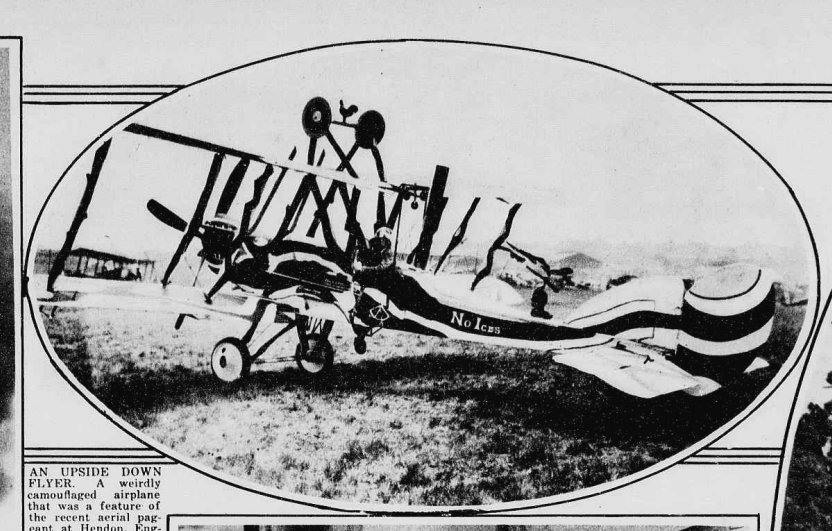
| Left: Aeroplane with (possibly dummy) extra wheels for landing inverted: 1921
The full caption reads: "AN UPSIDE DOWN FLYER: A weirdly camouflaged airplane that was a feature of the recent aerial pageant at Hendon, England. Note the dummy landing carriage atop the upper plane and sihouetted pilot's head beneath the fusilage designed to puzzle the spectators as to whether or not the plane is flying rightside up."
This picture provokes many questions. The fuselage looks oddly contorted, even allowing for the effect of the 'dazzle' camouflage. The real pilot appears to be sitting just behind the wings (which is where you would expect him to be, to get the centre-of-gravity in the right place) There is, as the caption says, a cutout pilot's head beneath the fuselage, under the real pilot's position. There is another cutout pilot's head at the rear of the fuselage, just in front of the tail fin; presumably this was also to 'puzzle spectators'.
There is a cutout cockerel mounted on the axle of the upper wheels; its significance is unknown. There is also 'No Ices' written on the side of the plane; is this a warning the pilot is not selling ice-cream from his aeroplane? Why should anyone think he was?
It is thought the aeroplane may be a Airco DH9. There is no suggestion that the plane took off or landed inverted.
|
|
Thanks to Paul Dunlop for bringing this to my attention and providing the image.


| Left: Piper Cub monoplane modified by Mike Murphy for use in US airshows: 1939
Judging by the tailfin, the aircraft is shown here parked upside down, but on the other hand the wing braces suggest it is the right way up. The pilot appears to be in position under the aircraft, and there is what is presumably a dummy head poking up on top. Murphy could take off or land either right-way-up or inverted.
The aeroplane was constructed for the 1939 National Air Races at Cleveland, OH. The plane was made from the parts of two Cubs, according to Flying Magazine. They presumably mean the Piper Cub.
This photograph appeared in Flying Magazine for Mar 1940, p54. Thanks to Paul Dunlop for bringing this to my attention and providing the image.
|
|
There is (sort of) a video. Murphy's plane can be glimpsed at 10min 27sec, as the camera pans past it.
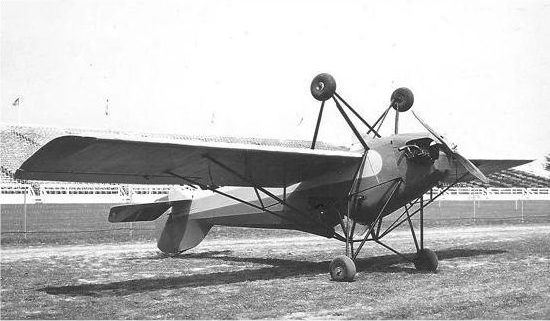
| Left: Piper Cub monoplane modified by Mike Murphy for use in US airshows: 1939
Photo taken at an airshow. Once more it appearws to be parked upside down, but may not be. The website that carries the picture says "Murphy A-1 Over-and-Under, an airshow plane that could only land and take off with the pilot sitting upside down. The top landing gear was fake. Built from the remains of a Taylor E-2 Cub. Circa 1935."
Thanks to Paul Dunlop for bringing this to my attention and providing the image.
|
|


| Left: S-2 Pitts aeroplane with dummy extra wheels for inverted takeoff and landing : 1980s
Craig Hosking of Los Angles CA, came up with an act for the Carolina Airshow, in which he took off in a modified S-2 Pitts Special he named "Double Take," performed a full aerobatic routine, then landed inverted. Hosking learned to accomplish this by repeatedly taking-off inverted, and landing upright. He then used a construction crane to turn the Pitts over and take-off inverted again. After becoming comfortable with an inverted take-off, he then taught himself to land up-side down. I can only admire his effort.
Hosking retired the inverted act around 1988 and went into movie stunt-flying full time.
Thanks to Paul Dunlop for bringing this to my attention and providing the image.
|
|
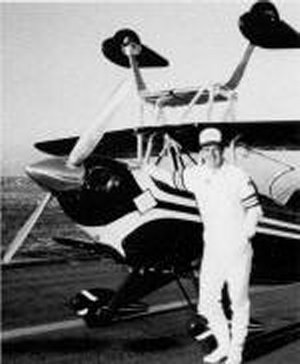
| Left: Craig Hoskins with his modified S-2 Pitts Special aeroplane: 1980s
Unfortunately the image is of poor quality.
There is more info on Craig Hosking here. and he has his own
website.
|
|

| Left: Craig Hoskins and his modified S-2 Pitts Special aeroplane: 1980s
Judging by the blur of the propellor, the aircarft is either taking of or landing inverted. According to the accompanying text, an electric winch was used to enter the cockpit.
Source: The World's Strangest Aircraft by Michael Taylor, pub Regency House 1996
|
|

PUTTING THE GUN IN FRONT OF THE PROPELLOR
In the early days of air-combat, there was a major problem with firing forwards- the propellor was in the way. It was not practical to mount the guns outside the propellor disc because they pilot need to be able to reach them to clear jams. There was the direct approach- fit steel protector plates to the wooden propellor blades, so that bullets would bounce off rather than chew up the propellor. This was never very satisfactory, not least because it wasted a certain proportion of the rounds fired. A more subtle but much more difficult method was synchronisation- the gun was linked to the propellor so that it only fired when there was no blade in the way. The Wikipedia article linked to just above is impressively comprehensive.
Given these difficulties, a few people tried a third way- put the gunner in a small turret mounted in front of the propellor.
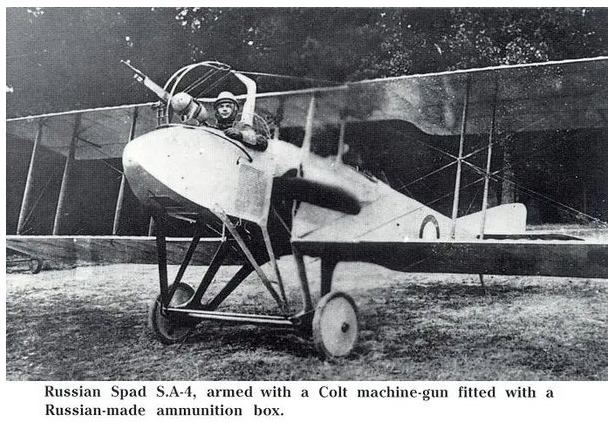
| Left: SPAD SA-4 : 1915
The SPAD SA was an unimpressive biplane built by the French SPAD company from 1915 onwards. The gunner sat in a small nacelle just in front of the two-blade propellor. This nacelle had to have its mountings outside the propellor disc, and the picture shows four struts running upwards from the undercarriage, and suspension wires to hold it up running forward from the leading edge of the wing.
There are some fairly obvious problems with this brilliant idea. The vibration of the nacelle was severe, and in multiple cases, it fell off the rest of the aircraft while in flight, to the dismay of the gunner. The gunner was unlikely to survive even a minor crash as the weight of the engine was just behind him. The noise of the engine made any communication between pilot and gunner impossible. The Le Rhône rotary engine tended to overheat as the nacelle blocked the air flow to it.
Just visible behind the gunner is a metal grid intended to stop the gunner getting an arm enmeshed with the propellor.
|
|
The SPAD SA was rarely used by the French, being recognised as a dangerous aeroplane. It was used by the Imperial Russian Air Service, who operated the SPAD S.A-2 and S.A-4, in the absence of anything better. SPAD in Russian means 'plummet' and that did not help crew morale.

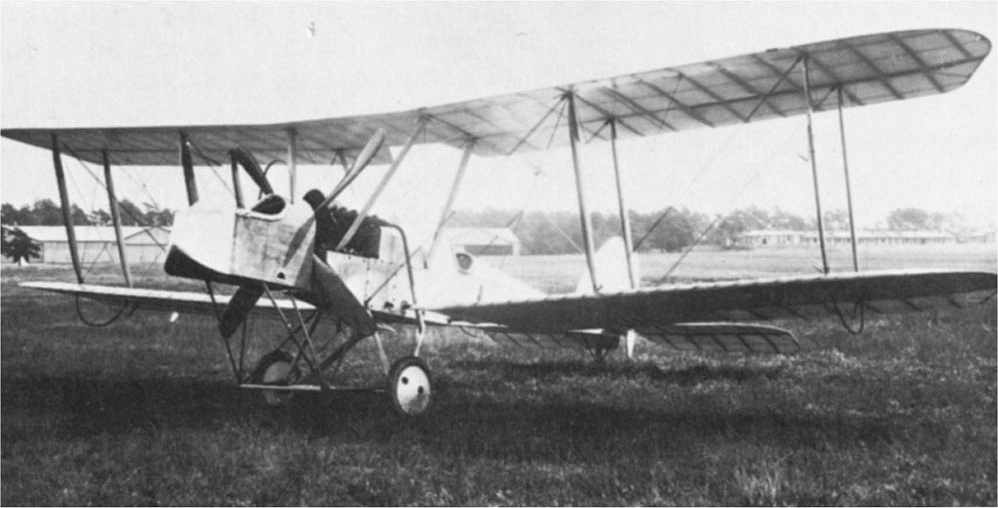
| Left: British BE-9: 1915
In 1915 the synchronisation problem was very much unsolved. The Royal Aircraft Factory took an existing design, the BE2c biplane, and added a gunner's nacelle in front of the propellor. The aircraft was 29 feet long with a wingspan of 40 feet, and was powered by a RAF 1a V8 air-cooled engine giving 90 HP to drive the four-bladed propellor. Maximum speed was an unimpressive 82 mph, and it took 4.5 minutes to reach 1000 feet.
As with the SPAD, the nacelle was held up by four struts attached to the undercarriage, and there appears to be a vertical post attached to the rear of the nacelle.
|
|
The Royal Flying Corps were unimpressed, with Major Hugh Dowding, then commander of 16 Squadron, stating that the BE9 was "...an extremely dangerous machine from the passenger's point of view". The prototype was not repeated. The BE9 has a Wikipedia page.
THE ZERBE AIR SEDAN: 1921


| Left: The Zerbe Air Sedan: 1919?
The Zerbe Air Sedan was a single-engine quadruplane passenger aircraft designed by Professor James Slough Zerbe in the USA in 1918. The machine made one flight in 1921, was damaged during landing, and was subsequently abandoned. There is a Wikipedia page.
"One of the first airliner concepts conceived by Jerome 'James' Slough Zerbe (1849-1921), different sources claim different years: 1909, 1910, 1914, 1918 or 1919. Reports claim the photo shows the quadruplane to be readied for test flight in 1919 at the Fayetteville, Arkansas fair grounds. Reports say the plane took off very quickly, rose to about 100 ft (30 m), flew approximately 1000 ft (300 m), and landed damaging its landing gear. After that Zerbe left town never to be heard of or seen again. What happened to the abandoned damaged plane is unknown."
To me the design of the cowling and propellor design suggest a late date, possibly 1919 but certainly not 1909. Wikipedia says the year of the flight was 1921.
|
|
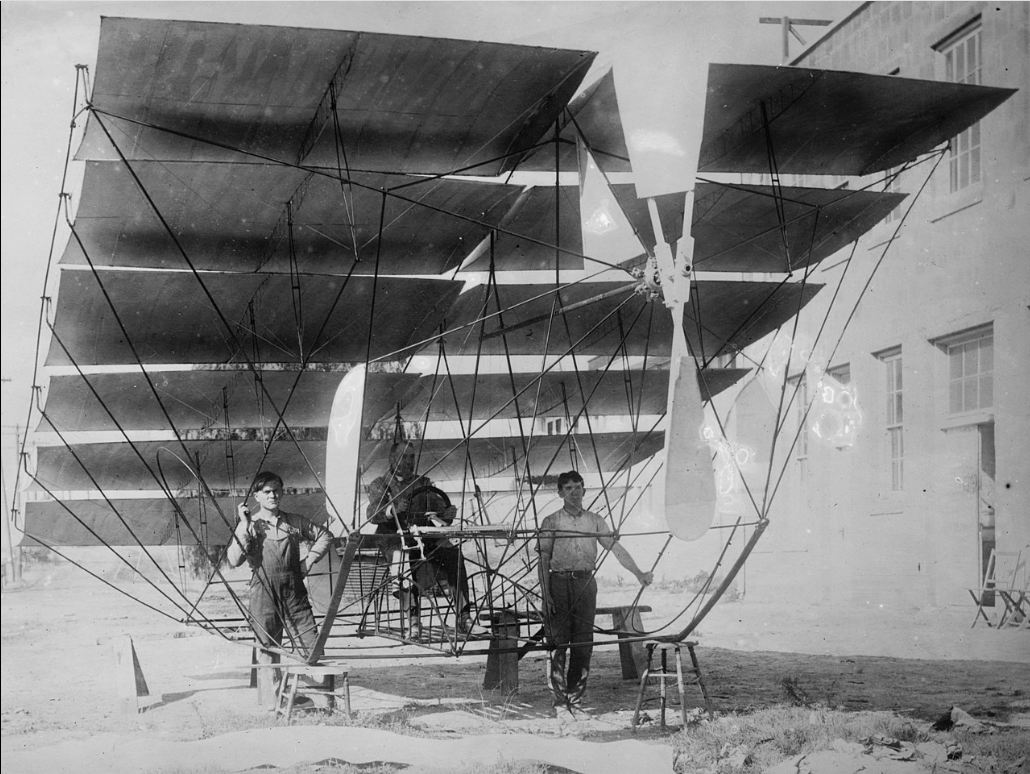
| Left: The Zerbe Hexaplane: 1908
Zerbe had previously designed a hexaplane with six staggered wings; see Wikipedia. It was again a large aeroplane with a single tractor engine. It is unknown if this machine was ever flown and if so what happened. The fact that there actually appears to be no engine installed here suggests it was never completed.
|
|

| Left: The Zerbe Quintaplane: 1908
Zerbe had also previously designed not one but three quintaplanes with five staggered wings; see Wikipedia.
There is more information on this quintaplane here,
and also here.
|
|
It seems to me we need a gallery of N-winged aircraft... the record appears to be 200 wings. Yes, two hundred.
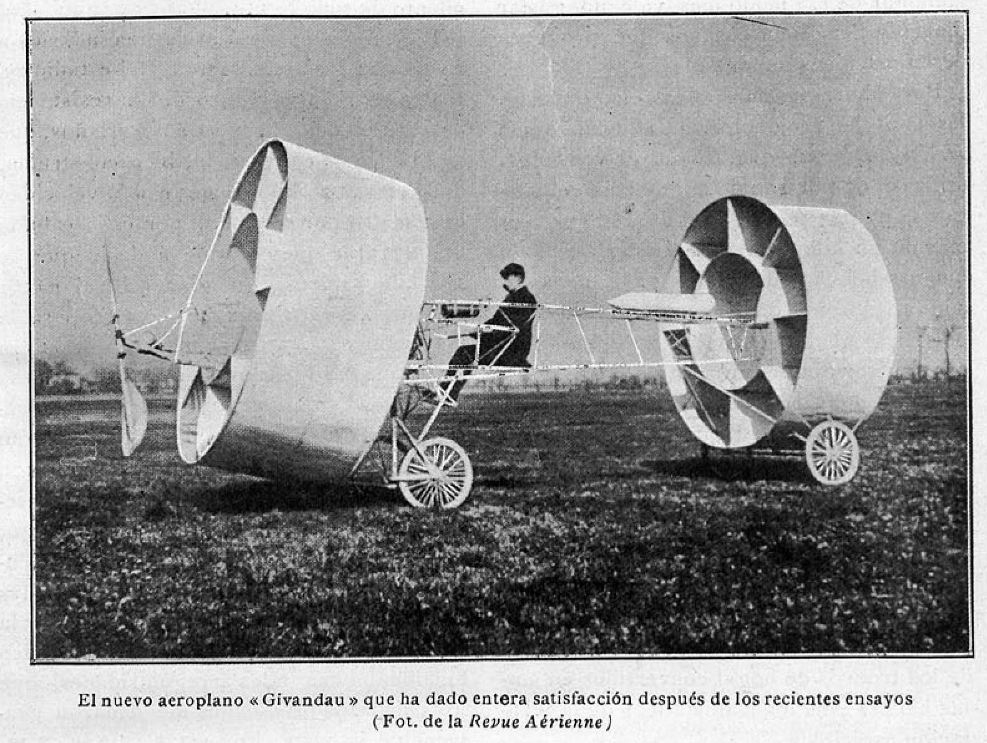
| Left: The Givaudan flyer: 1909
It is hard to say how many 'wings' this machine had, and hard to work out on what principles Claude Givaudan (1872-1945) was hoping to fly it. It was constructed at the automobile factory Usines Vermorel at Villefranche, where Givaudan was employed. The front 'wing' swivelled up and down to act as an elvator; an arrangement that is inherently unstable. The wing at the back could move left and right to act as a rudder. It had Power a Vermoral engine rated at 50 HP.
The Spanish caption says: "The new Givaudan aeroplane which has given full satisfaction after the recent reviews', but what these reviews were is enigmatic. Other sources state firmly it never flew, and frankly I'm not surprised.
|
|
Note wrong spelling of Givaudan in the caption.

| Left: The Givaudan flyer: 1909
More of a non-flyer.
The text says that the front 'wing' swivelled in two axes and the rear was fixed, though this contradicts other sources. Note the fuel tank designed for low drag using the very limited aerodynamic knowledge of the day, with a sharp point at the front. A smooth curve, like the nose of a modern aeroplane, creates less drag than a point, though it is perhaps counter-intuitive. That's aerodynamics for you.
|
|
Although this design was a total failure Givaudan had a long career in cars and aviation. At the end of his life he was the president of the Aéro Club de Rhône.
Flight magazine described the Givaudan flyer on p282 in 1909. Access to this has not yet been obtained.
There is more information here, and here.















